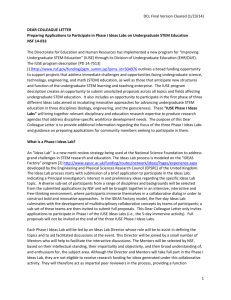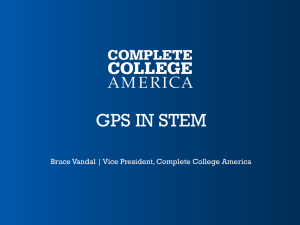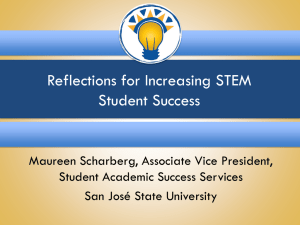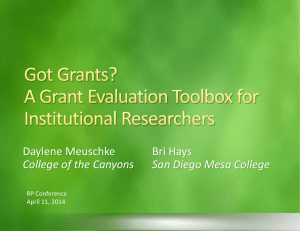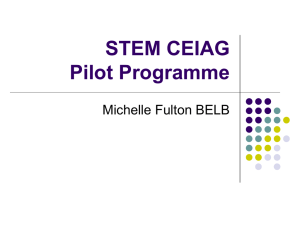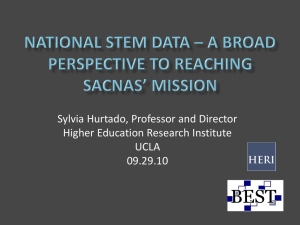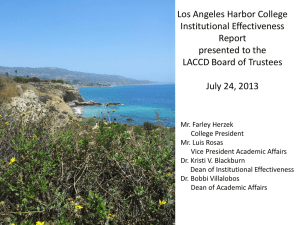here for the PDF - Education and Human Resources
advertisement
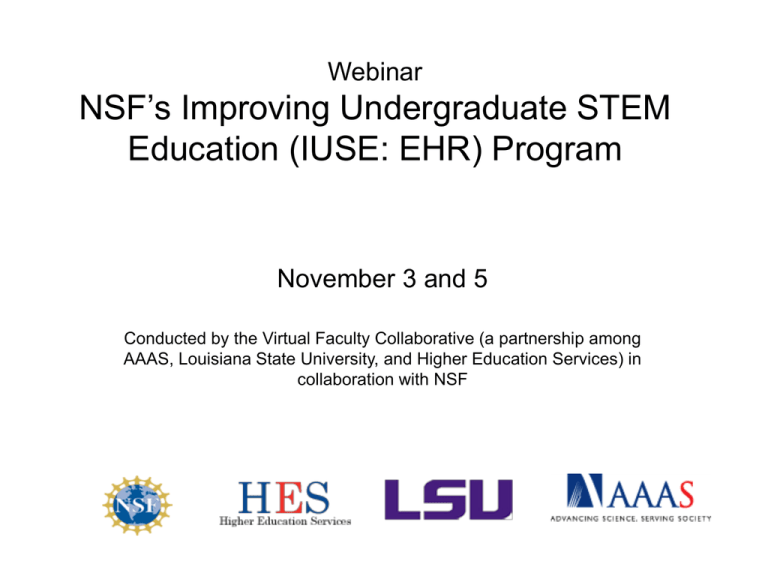
Webinar NSF’s Improving Undergraduate STEM Education (IUSE: EHR) Program November 3 and 5 Conducted by the Virtual Faculty Collaborative (a partnership among AAAS, Louisiana State University, and Higher Education Services) in collaboration with NSF Presenters and NSF Participants • Presenters – Russ Pimmel, U of Alabama, russpimmel@gmail.com – Sheryl Sorby, Ohio State U, sheryl@mtu.edu – Lance C. Pérez, U of Nebraska, lperez1@unl.edu • NSF Participants – Myles Boylan, mboylan@nsf.gov – Kate Denniston, kdennist@nsf.gov This session is being recorded Webinar Slides • Webinar slides are available at website – http://ehrweb01.aaas.org/stem-iwbw/ – Google “AAAS IUSE” • Recorded version of webinar – www.nsflsu.com – Google “ LSU NSF IUSE” Disclaimer • This Webinar represents the opinions of the presenters and it is not an official NSF document • Presenters have all served several years as NSF Program Directors in DUE, but they are not currently affiliated with NSF • In preparing the webinar materials, the presenters have had several discussions with these IUSE Program Officers and have incorporated their suggestions into this presentation Kate Denniston or Myles Boylan, who will be responding to questions during the webinar, are responsible for the IUSE:EHR Program (together with Connie Della-Piana and Terry Woodin) Webinar Topics • Introduction to IUSE:EHR Program • Program description – Engaged Student Learning Track – Institution and Community Transformation Track • Q&A #1 • Additional program details – Important program considerations – Workshops, conferences and special projects – Review criteria • Proposal preparation advice • Q&A #2 Q&A Sessions • There will be a Q&A session approximately halfway through the Webinar and another one at the end • Attendees can type their questions in the QUESTION BOX at any time • One of the presenters will monitor the Question Box and formulate a set of representative questions to ask the participating NSF Program Officer during the two Q&A Sessions IUSE:EHR Introduction IUSE:EHR Introduction • IUSE:EHR is in its second year of operation – First year that proposals are guided by a solicitation • IUSE:EHR is a broad program focused on undergraduate STEM education – For all types of institutions of higher education – K-12 science and mathematics except in unusual circumstances are not included IUSE Vision • All undergraduate students fully engaged in their STEM learning – Both majors and non-majors • Institutions of higher education deeply committed to broad use of research-based teaching approaches Expanded IUSE:EHR Vision Statement STEM departments and instructors at all types in institutions of higher education • Routinely use evidence-based teaching and learning practices • Use assessment to enhance the evidence base of effective teaching and learning • Make changes to improve student learning based on assessment data • Remain alert to ideas and opportunities to improve the quality of student engagement and learning IUSE:EHR Goals • Improve STEM Learning & Learning Environments: – Improve the knowledge base for defining, identifying, and innovating effective teaching and learning – Foster widespread use of evidence-based resources and pedagogies • Broaden Participation & Institutional Capacity for STEM Learning: – Increase the number and diversity of STEM majors by improving and using evidence-based strategies • Build the Professional STEM Workforce for Tomorrow: – Enable students to become productive members of the STEM work force and of our STEM-literate society IUSE:EHR Program Tracks and Funding Tiers • Engaged Student Learning Track – Exploration (up to $250K, 2 years) – Design and Development Tier -- Level l (up to $600K, 3 years) – Design and Development Tier – Level ll ($601K-$2M, 5 years) • Institutional and Community Transformation Track – Exploration Tier – (up to $250K, 2 years) – Design and Development Tier -- (up to $3M, 5 years) • Research studies can be submitted to either Track • Workshops, and special project proposals are also encouraged Engaged Student Learning Track IUSE:EHR Engaged Student Learning Track Engaged Student Learning Track Projects • Focus on design, development, and research studies • Involve the creation, exploration, or implementation of tools, resources, and models that show promise for – Increasing engagement in STEM learning – Leading to measurable and lasting learning gains • Reflect disciplinary differences in needs and priorities Engaged Student Learning Track Collaborations • Collaborations are encouraged among – STEM disciplinary researchers – Education researchers – Cognitive scientists • Such collaborations should – Leverage what is known about how people learn – Contribute to the growth of that body of knowledge Engaged Student Learning Track Target Populations Target populations include – Students at two- and four-year schools – STEM majors seeking solid skills and knowledge of STEM principles – Non STEM majors seeking to fulfill a general education requirement in STEM – Faculty members Engaged Student Learning Track Exploration Projects • Small-scale efforts – Deadline of Oct 22 – Budgets up to $250,000 – Maximum duration of 2 years • These projects may seek to – Pose and investigate new teaching materials or instructional strategies – Pose and investigate new methods of assessing student learning and achievement – Adapt and implement strategies that have proven effective at other institutions – Many others consistent with IUSE Program goals • Expected to contribute to the body of knowledge about – STEM teaching and learning – Effective means to broader implementation Engaged Student Learning Track Design and Development Projects– Level l • Larger projects – Deadline of Jan 13 – Budget up to $600,000 – Maximum duration of 3 years • Focus on achieving – More refinement of working prototypes and approaches – Testing and propagation beyond a single institution or – Impacts across multiple STEM disciplines within an institution • Evaluation should produce quality evidence on the effectiveness of the project used in multiple settings Engaged Student Learning Track Design and Development Projects – Level ll • Largest scale projects – Deadline of Jan 13 – Budget between $601,000 and $2,000,000 – Maximum duration of 5 years • Intended to support – Initiatives that have been found to be effective at smaller scales – Large-scale efforts – Long-term research on impacts • As with Level I grants, evaluation should produce quality evidence on the effectiveness of the project used in multiple settings Engaged Student Learning Track Sample Project Themes Some possible themes may include: – – – – – – Assessment/metrics of learning and practice Conducting undergraduate disciplinary research Developing the STEM and STEM-related workforce Educating a STEM-literate populace Broadening participation in STEM Exploring co-curricular activities to increase student motivation and persistence – Faculty learning through professional development – Building capacity in higher education These are examples; other themes are appropriate Institutional and Community Transformation Track Institutional and Community Transformation Focus Institutional and Community Transformation projects may • Use innovative approaches to increase the propagation of highly effective teaching and learning methods • Use technology and distance education methods (or hybrid designs) – When supported by evidence of potential effectiveness • Cut across institutions • Focus on – Disciplinary need (e.g. gatekeeper courses in biology) – Pedagogical approach (e.g. using SCALE-UP in physics) – Interdisciplinary programs or combinations of disciplines Institutional and Community Transformation Track Expectations • Projects are expected to be both knowledgebased and knowledge-generating Institutional and Community Transformation Track Exploration Projects • Small-scale efforts – Deadline of Oct 24 – Budgets up to $250,000 – Maximum durations of 2 years • These projects may seek to – Develop strategies for the adoption, adaptation, and implementation of effective practices by a growing number of faculty instructors – Explore challenges to their adoption, with the goal of informing policy, practice, and future development in education enterprise • Expected to contribute to the body of knowledge about – STEM teaching and learning – Effective means to broader implementation Institutional and Community Transformation Track Design and Development Project • Large scale projects – Deadline Jan 13 – Budget limit of $3,000,000 – Maximum duration of 5 years • Typically focus on achieving – Propagation beyond a single institution – Change across multiple STEM disciplines within an institution • Evaluation should produce high quality evidence about the effectiveness of the project. – In effect these large projects are applied research projects investigating the effectiveness of models of change. Institutional and Community Transformation Track Sample Project Themes Projects may • Use technology and distance education methods • Begin institutional planning efforts • Investigate approaches to increase the importance placed on evidence-based practices in institutional strategic planning and faculty rewards • Involve faculty in continued professional development • Develop instruments and metrics to assess institutional shifts towards evidence-based teaching • Determine the applicability of change theories from other sectors in changing institution-wide cultural norms • Research approaches for advancing change These are examples and other themes are appropriate Institutional and Community Transformation Track Institutional Change Projects • IUSE:EHR projects that intend to promote institutional change will typically require – Teams of faculty members – Support from the department chairs, college deans, or other individual within the institution's academic leadership – Support from Provosts or Presidents for large projects is recommended • These projects should – Be guided by explicit theories of change – Test hypotheses about transforming STEM teaching and learning by examining the impact of deliberate processes of change Q&A -1 Type your questions into the QUESTION BOX Important Considerations Some Emphasis Areas in IUSE:EHR Solicitation Interaction Between STEM Education Research and Practice • Collaborations among STEM disciplinary experts and STEM education researchers fosters a “cycle of innovation” – New questions emerge from innovative practice to be solved by new research – New solutions derived from research to be implemented through modified practice • Collaboration among STEM disciplinary experts, STEM education researchers or cognitive scientists, and STEM education practitioners are encouraged Transportability and Propagation Expectation • Transferability and propagation are important considerations for IUSE-supported efforts – They should be addressed throughout a project's lifetime – Approaches should be designed for use in a large variety of institutions • Principal Investigators are encouraged to consider – The value of the project from the perspective of other users – The relationships, partners, and structures which would eventually be needed to sustain the improvement on a wide scale Knowledge-Based and KnowledgeGenerating • Projects are expected to be both knowledge-based and knowledgegenerating – They should leverage what is known about how students learn in the STEM focus area of the proposal – They should endeavor to contribute to that body of knowledge • Successful projects can act locally should also think nationally – Seek to produce valuable changes locally – Seek to generate knowledge that would be useful to other STEM faculty in other institutions • Knowledge producing aspect is more than project evaluation – It is research that is contextualized within teaching practices, institutional goals, and student impacts The Monograph on “Common Guidelines for Education R&D” (August, 2013) may be helpful in designing the evaluation/ knowledge producing part of a good proposal Research Project Proposals Research Projects • Projects that are predominantly research studies may be submitted to either IUSE: EHR Track • Research may explore – Enhancement of student learning and attitudes through teaching strategies and effective curricula – Diffusion of widespread practices through the community – Effective professional development approaches for instructors – Effective institutional change models These are examples and other themes are appropriate Special Projects Workshops, Conferences, and Special Projects • Proposals for workshops and other special projects addressing critical challenges in undergraduate STEM education may be submitted at any time following consultation with an NSF Program Officer • IUSE:EHR Program welcomes small projects, up to a maximum of $75,000, to explore revolutionary ideas to improve undergraduate STEM education Review Criteria NSF Merit Review Principles – NSF projects should be of the highest quality and have the potential to advance, if not transform, the frontiers of knowledge – NSF projects, in the aggregate, should contribute more broadly to achieving societal goals – Meaningful assessment and evaluation of NSF-funded projects should be based on appropriate metrics, keeping in mind the likely correlation between the effect of Broader Impacts and the resources provided to implement projects • With respect to assessment and evaluation, projects should include clearly stated goals, specific descriptions of the activities that the PI intends to do, and a plan in place to document the outputs of those activities. NSF Merit Review Criteria • • Intellectual Merit – the potential to advance knowledge Broader Impacts – the potential to benefit society and contribute to the achievement of specific, desired societal outcomes Both criteria, Intellectual Merit and Broader Impacts, will be given full consideration during the review and decisionmaking processes. Proposers must fully address both criteria Merit Review Considerations • What is the potential for the proposed activity to: Advance knowledge and understanding within its own field or across different fields (Intellectual Merit) Benefit society or advance desired societal outcomes (Broader Impacts)? • To what extent does the proposed activity suggest and explore creative, original or potentially transformative concepts? Merit Review Considerations (Cont.) • Is the plan for carrying out the proposed activities wellreasoned, well-organized, and based on a sound rationale? • Does the plan incorporate a mechanism to assess success? • How well qualified is the individual, team, or organization to conduct the proposed activities? • Are there adequate resources available to the PI (either at the home institution or through collaborations) to carry out the proposed activities? Please Note: Reviewers are also asked to review Facilities, Equipment and Other Resources, Data Management Plan, and Postdoctoral Researcher Mentoring Plan Presenters’ Advice Proposal Advice -- Disclaimer • The following slides provide some advice on how to address the newer emphases in the IUSE:EHR Program Solicitation • Whereas the earlier material was developed from the solicitation, the following slides represent the presenters’ opinions and not NSF guidance Knowledge-Based Expectation • As you would do for a research proposal – Provide an evidence-based justification of the importance of the proposed topic – Provide an evidence-based justification of the selected approach • These should be substantial discussions with references to the literature • Do this for proposals for both tracks – Engaging Student Learning Track – Institution and Community Transformation Knowledge-Generating Expectation • Describe plans for collecting, analyzing, and sharing data • Make evaluation an integral part of the project – – – – Include goals and objectives (intended outcomes) Identify your evaluator Include an evaluation plan to determine the effect of the intervention Describe how the evaluation results will be a basis for publication • Do this for proposals in both – Engaging Student Learning Track – Institution and Community Transformation Transportability and Propagation Expectation • Describe your plans for making your project transportable • Describe your plans for encouraging, enabling, and facilitating its use by others • Provide an evidence-based justification for your approaches • Include this aspect in your project evaluation effort • Do this for proposals in both – Engaging Student Learning Track – Institution and Community Transformation Broader Impact Expectation • Include goals, objectives (intended outcomes) and plans for broader impact • Provide a literature-based justification for the approach • Include this aspect in your project evaluation effort • Do this for proposals in both tracks – Engaging Student Learning Track – Institution and Community Transformation Q&A – 2 Type your questions into the QUESTION BOX Webinar Slides • Webinar slides are available at website – http://ehrweb01.aaas.org/stem-iwbw/ – Google “AAAS IUSE” • Recorded version of webinar – www.nsflsu.com – Google “ LSU NSF IUSE” IUSE Website • For more information on IUSE Program visit • http://www.nsf.gov/funding/pgm_summ.jsp?pims_id=505082 • Google “NSF IUSE” IWBWs • Presenters have organized a series of interactive web-based workshops (IWBWs) on various of project development – IWBWs begin on Nov 6 and continue to Nov 20 – Topics: • • • • • Proposal Writing Strategies Project Goals and Objective Project Evaluation Project Impact and Transportability Broader Impacts – IWBWs require an local facilitator to coordinate the on-campus activities • For more information – Go to the website at • http://ehrweb01.aaas.org/stem-iwbw/ – Google “AAAS IWBW” Thank you for your participation and good luck with your proposals
